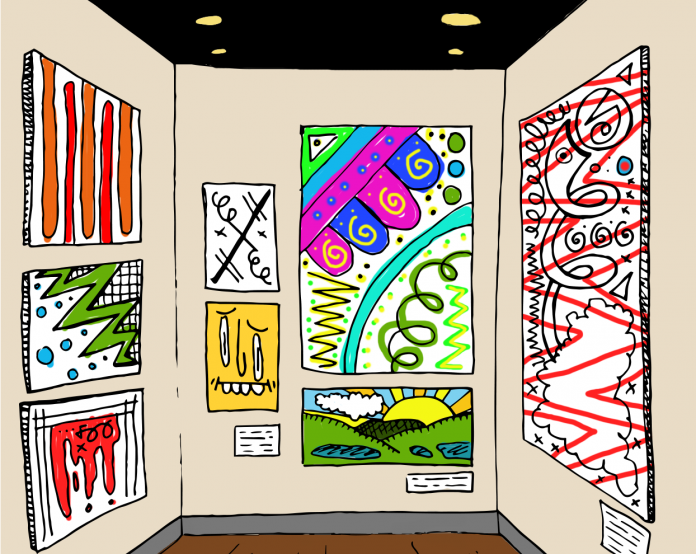 On the surface, UFV’s Abbotsford campus is very blunt about it being a university campus. Whoever planned the space must have thought: well, a university needs buildings and parking. Parking takes care of itself. You pave some land, draw some lines, and there you go — parking. The buildings, it seems, were designed to project their very essence at their inhabitants. Full of classrooms, these buildings seem desperate to tell us something, to declare it sternly, and with a measured tone: This is a place of learning, they seem to say.
On the surface, UFV’s Abbotsford campus is very blunt about it being a university campus. Whoever planned the space must have thought: well, a university needs buildings and parking. Parking takes care of itself. You pave some land, draw some lines, and there you go — parking. The buildings, it seems, were designed to project their very essence at their inhabitants. Full of classrooms, these buildings seem desperate to tell us something, to declare it sternly, and with a measured tone: This is a place of learning, they seem to say.
So it is, but it is also so much more.
Curious students have doubtless stumbled into C building at various times throughout the year and found its walls dotted with sketches, drawings, and paintings; students running to and from studio spaces with brushes, cameras, and other supplies.
There is learning at UFV, but there is also making. There is also art. It’s on the top floor of the Student Union Building, on the walls and corners of C building, and in the S’eliyemetaxwtexw Gallery. Who makes the art that goes up on the walls of our campus? How does it get there, and what does it mean for the UFV community?
In order to get a grip on the process of art-making at UFV, we spoke with UFV’s widespread and varied community of artists: we spoke to professors, ready and willing to impart skills and knowledge to their pupils; to students, one connected to the community at this institution, and the other continuing her journey as an artist by embracing the resources available to her. Out on the fringes, a graduate tackles the real world with enthusiasm after leaving a unique signature on the walls of UFV’s newest building and student hub. Together, these voices tell us just as much about the burgeoning community of artists in the Fraser Valley as they do about the community of minds coming together within the walls of UFV, learning and collaborating, exchanging ideas and skills, all in an effort to create something new.
Learning Art at UFV
For students like Sidi Chen, an outgoing visual arts major who focuses mostly on painting, and Paige Caldwell, a fourth-year student who works primarily in charcoal on plywood panels, education in the arts at UFV has been a twofold process of book-learning and hands-on work.
Chen notes that he spends as much time on readings as he does brushing up on, well, brushing.
“Through art history courses, you get a lot of information and theory. The higher you go, the more freedom you have to direct where your projects go. That’s not to say that before you don’t have freedom, you still do, but there are more requirements on the technical side.”
As our conversation moves forward, I get the sense that, apart from a steadfast commitment to the progression of his work, there’s nothing out of the ordinary about Chen except, perhaps, diligence. He tells me he’s been painting since he was five. He’s had training in colour theory and basic art practices from an early age. These childhood resources have proved their usefulness over and over again, but none of them are game changers, none lay outside the grasp of any other student.
Caldwell explains that visual arts staff at UFV focus on giving students skills they can actually use. She notes her education has been, above all, pragmatic.
“All the professors I’ve had in studio courses talk about getting a portfolio set up, and setting yourself up to be able to apply to galleries if you’re going in an independent route,” says Caldwell. “They tell you that it’s a lot of self-promotion — 80 per cent self-promotion, 20 per cent doing the work. That’s been really helpful. Not so much the studio part of it, but how you’re going to get your stuff out there.”
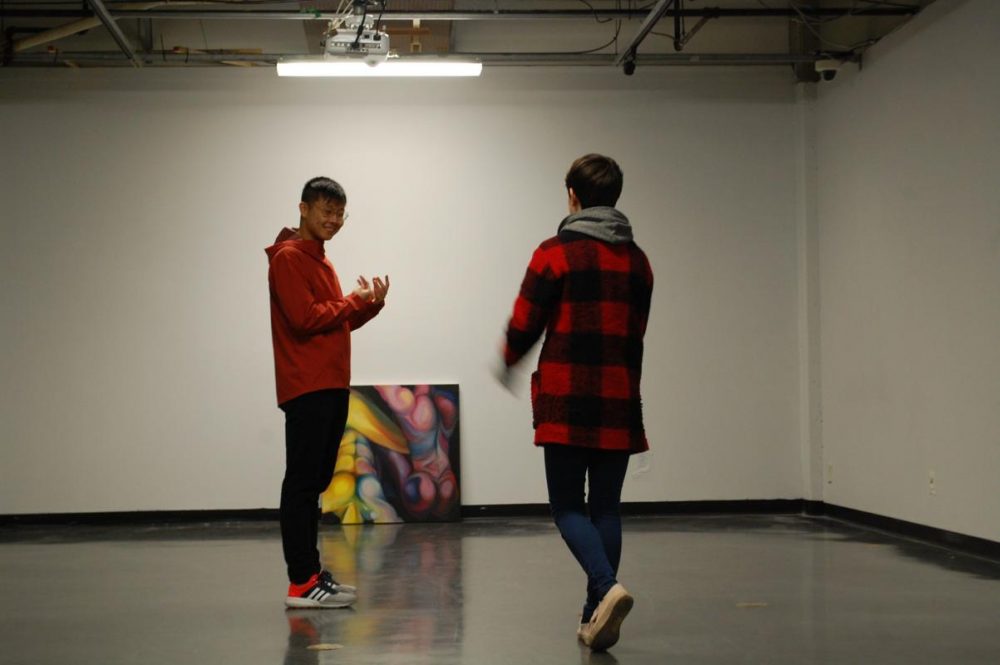
Displaying work at UFV
For a community to exist, whether it’s self-contained or pervasive, there must exist within its structure a foundational principle based on communication between its members. There can be no community of artists at UFV without the exchange of ideas and expressions between its members. Self-contained displays in classrooms only go so far in creating, in students’ minds, the instinctual, organic connection to their peers necessary for the blossoming of a true community of artists. When it comes to visual arts, there’s no better way to foster that community than to display the work that it produces. Seeing art on the walls gives students a reprieve from the off-white monotony common to most of UFV’s buildings, and— even more importantly — it is constitutive of a conversation, of an exchange of ideas.
As Chen tells me, UFV offers plenty of opportunities for students looking to showcase their work. Throughout C building, there’s available space for displaying student work.
“Everyone knows they can book a wall and put their stuff up,” says Chen. “As long as they’re responsible for taking it down and patching the wall, everything’s good.”

Caldwell echoes these comments, saying that displaying art at UFV is easier than it seems from an outside perspective. “You can do that any time, and put [your work] up for however long. You just gotta do it.”
The booking format for space on these walls is old-fashioned, but effective. A paper schedule is available to students in C building, which displays the available times for using wall space throughout the building. Despite its simplicity, the booking process is not a walk in the park.
“You need to be very self-directed,” says Chen. “Where is the best place to present your work? When is the space available?”
As great a resource as the walls of C building are, there exists, for students looking to put together a more professional display of their work, a second option at UFV: The S’eliyematexwtexw Gallery.
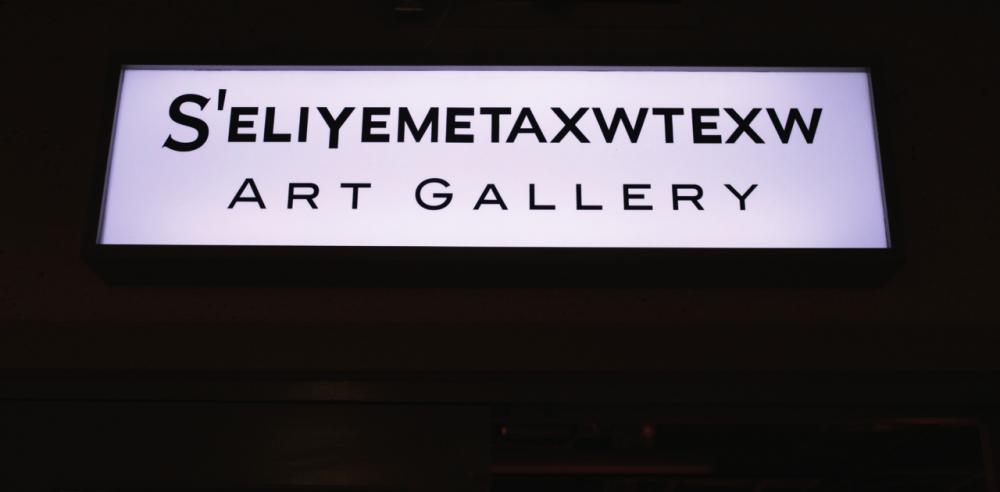
S’eliyemetaxwtexw Art Gallery
Students don’t have to walk too far into B building before they stumble into UFV’s most wondrous, magical room: B136, the S’eliyemetaxwtexw Gallery.
Space in the S’eliyemetaxwtexw Gallery isn’t as easily booked as space in C building, and the job of overseeing the space falls to associate professor of sculpture and extended media, Melanie Jones. As one might expect, there’s quite a step up from booking a wall in C building, and scheduling an exhibition at the gallery.
“The S’eliyemetaxwtexw Gallery is a curated space, so it is not ‘booked’ in the same way a classroom or a meeting space is,” says Jones. “Once we review submissions, a schedule is made for the coming year’s exhibitions or events.”
Submissions for the gallery are reviewed annually, and students interested in exhibiting their work have to prepare to do so a year in advance. Students must write an artist statement, submit a proposal of what they plan to display in the gallery, include a CV, and supply an image list to the gallery.
Although the gallery receives a considerable amount of requests per year, Jones says that student work is given priority.
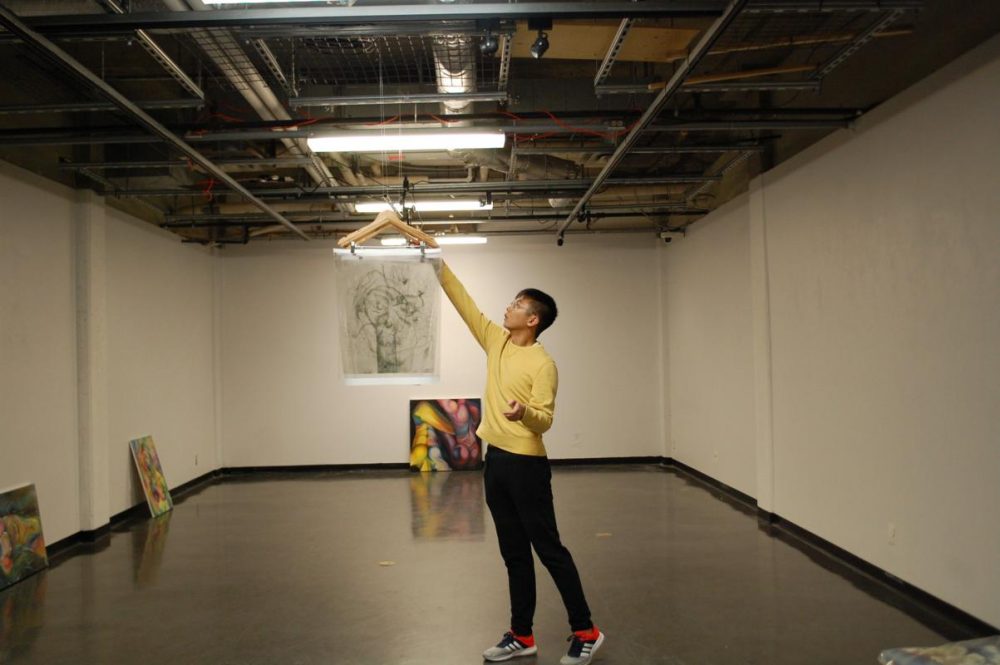
“We want to provide the unique and important opportunity for our students (current and alumni) to exhibit their work professionally.”
The gallery’s own guidelines for submissions give students a taste of what it’s like to exhibit work professionally.
“When an exhibition or event is given space in the gallery, the exhibitors are responsible for all aspects of the exhibition, but can consult with myself or the other gallery committee members/technicians for specific support, such as arranging projectors or lighting.”
Since the gallery is run entirely by volunteers, matters of installation are left up to students.
“We do not install or hang the artwork for the exhibitor — we require exhibitors to be present for the install of their work,” says Jones.
She adds that communication between students and the gallery is key in the smooth transition from one exhibit to the next.
“If a student cannot be present to retrieve work, then it is likely that arrangements could be made in advance. If there is significant damage, or materials required to restore the space, we ask the exhibitor to take responsibility for those things as part of their agreement to use the space.”
Are these rules tough? Perhaps, but they do mimic the process that students will have to go through to display art at most major galleries. Standardizing the practice of installing exhibits as part of the reality of being an artist is a key step in making sure students are prepared to work professionally in their chosen field.
Jones understands the challenges that come with exhibiting at the S’eliyemetaxwtexw Gallery, but insists that they “offer students a launch pad to help them move forward in their careers.”
Submission schedule
Annual Call for Submissions – reviewed after the May 31 deadline.
Events that are scheduled every year include:
– the BFA Exhibition
– the Visual Arts Diploma Exhibition
– the BFA Silent Auction
– “Multiples” — an annual class project for VA 116.
While most students’ first encounter with UFV’s only art gallery will happen by chance, it’s evident that initiative is what’s brought Chen into the S’eliyemetaxwtexw Gallery today, where he turns to Caldwell, and asks for her opinion: Should two paintings go on the far wall, or just one?
Caldwell and Chen are hard at work preparing a forthcoming exhibition which will feature Chen’s paintings and mixed-media work, alongside Caldwell’s drawings.
Chen tries to gauge the size of a wall, and considers the lighting before explaining how he came to collaborate with Caldwell. He and Caldwell were both in the same painting class before summer, which gave them both the opportunity to experience each other’s work.
“I saw that there was a commonality between our work,” he says. “I asked if she wanted to put together a show with me, and she said yes.”
Caldwell notes that the experience of submitting a proposal to and organizing an exhibit in the S’eliyemetaxwtexw Gallery is more demanding than other local alternatives, like The Reach’s Emerge program.
“This is a different experience from [submitting to The Reach.] We’re setting the exhibit up, whereas in the Emerge gallery, they have a curator and staff which give you a lot of help. It was a good jump-start to be displayed in a gallery that gives you a lot of help. It helps you build up momentum.”
Co-curricular student involvement
UFV’s docent program allows up to 4 co-curricular record students to become docent/preparators (gallery attendants/handlers)
Students involved might be required to:
– Volunteer 1-2 hours per week. This time is spent in the gallery
– Provide information to visitors
– Help with the installation of exhibits
– Support exhibitors with installation, opening reception, or cleanup
As a learning tool, the S’eliyemetaxwtexw Gallery’s focus on being a resource which students can take advantage of independently of class places them in a sink-or-swim situation. Firstly, it falls to the student exhibiting their work to assure the process goes smoothly, and secondly, there’s no better cure for stage fright than having your work on display at a gallery within walking distance of the cafeteria.
“It’s really good to have this space in a separate building than C building,” says Caldwell. “Just walking around the school, there’s not a lot of art in it. Having a public gallery inside a school is very nice. If it wasn’t here, the rest of the school wouldn’t be aware of this art.”
Caldwell realizes there’s no avoiding the fact that your peers are bound to wander in sooner or later.
“Yes, people are going to look at your work. People are going to judge your work. You kind of have to get over it.”
After Graduation: Enter Meshaal Alzeer
If Chen and Caldwell are representative of artists at UFV, then Meshaal Alzeer is representative of artists from UFV. Before graduating in 2016, Alzeer painted and exhibited a striking series of paintings titled Portraits of the Unknown.
Adventurous students might recognize that as the joint title of the three huge, bold oil paintings of Muslim scientists and scholars currently hanging in a hallway on the topmost floor of the Student Union Building at UFV’s Abbotsford campus.
“That body of work was part of a directed study. Its aim was in revealing and shining light on ancient Muslim scientists,” says Alzeer. “I see that as kind of a big deal in terms of bridging [cultural] gaps, and breaking stereotypes.”
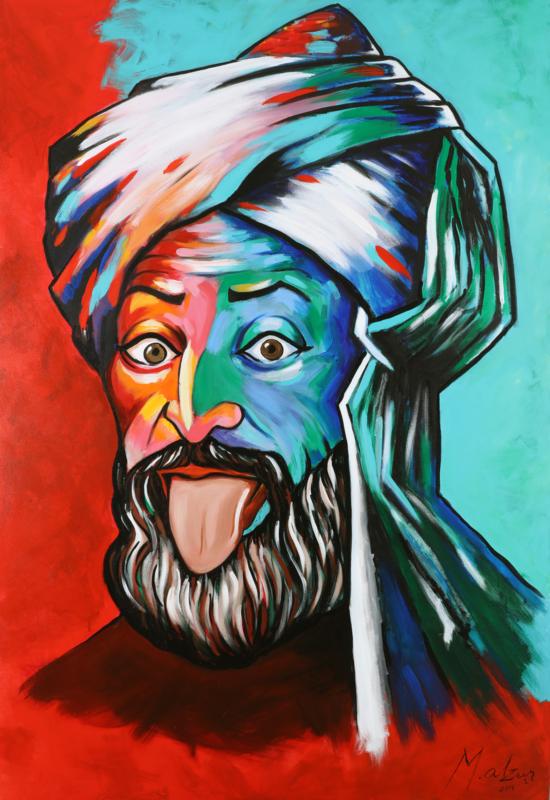
Evidently, it was also a big deal for well-connected visitors of the S’eliyemetaxwtexw Gallery at the time it featured his paintings. A member of the Student Union Society reached out to Alzeer, and spoke a phrase to him that I’m sure many art students dream about one day hearing.
“She said, ‘We like your body of work, we think it’s powerful, and we’d like to add it to our permanent collection.’ I’d heard that they purchased student work, which is very encouraging and motivating to students. I was lucky enough to be among those students whose artwork was purchased.”
Thinking back, Alzeer feels confident in the skills he gained during his time at UFV.
“Of course, right now, I’ve been out of school for a year, looking back at the work I’ve done in my school years, I think that I could have done better. I’m satisfied so far with what I’ve explored, and wanted to speak about and with my technical skills. I could have spent or invested more time, but in general it’s good. I’m satisfied.”
As an artist in his own right, and a member of the greater Abbotsford community of artists, Alzeer sees only opportunity on the horizon — for artists and facilitators alike.
“I’m involved with a few artists in the community who really want venues in Abbotsford. Abbotsford is developing right now, it’s becoming huge, and the arts sector will need attention. I’ve met people who really want to work together, share a workspace, exhibit together. I see a lot of potential for sure. There’s huge change.”
What does that mean for artists at UFV?
“There are opportunities, yes. In terms of finding them, artists need to get themselves out there. And [the same goes] for the people who are looking — suppliers, providers, patrons, benefactors.”
In an observation that should be brought to the ears of city planners as they budget growth for the city’s infrastructure, Alzeer notes three areas in need of improvement:
“[There needs to be] a focus on venues, affordability, [and] exposure.”
At this point, I think it’s fair to say that, if art is what Abbotsford wants, it doesn’t know what it’s got coming.
Schedule of upcoming shows
Skin Tactility — Sidi Chen & Paige Caldwell
October 16 – November 3, 2017
Opening Reception: October 16
VA116 (Intro to Studio II: Space, Form, and Time) Annual Exhibition
November 13 – December 5, 2017
Opening reception: November 13, 2017
Shoganai — Grace Tsurumaru (VA faculty member presenting her artist’s book)
December 8 – 14, 2017
Deep Sea Changes — Madeline Hildebrandt
January 8 – January 15, 2018
BFA Silent Auction
Jan 29 – Feb 2, 2018
Invisible Horizons — David Evans
February 6 – 26, 2018
pArticipate Poster Competition
March 1 – 15, 2018
Diploma Show
March 19 – April 6, 2018
BFA Grad Show
April 27 – May 18, 2018

